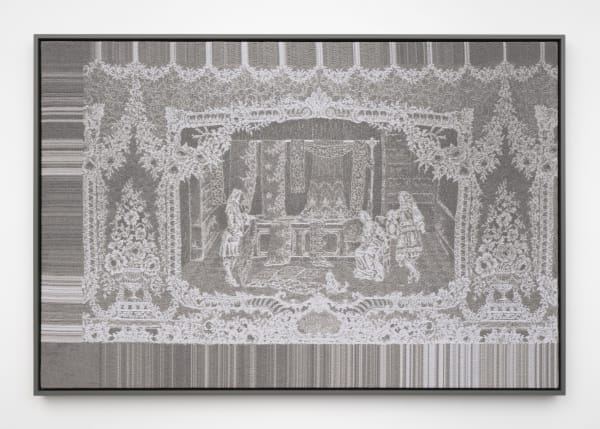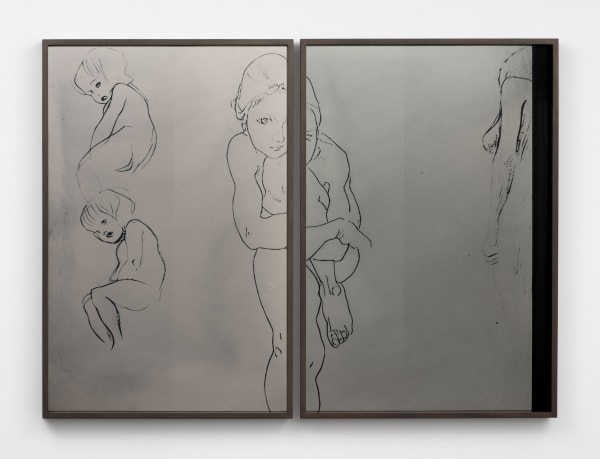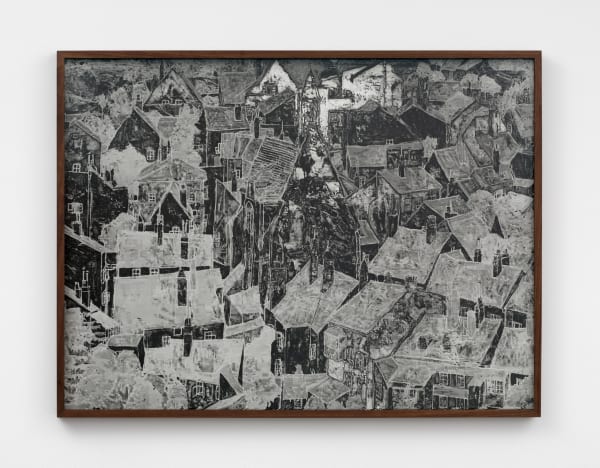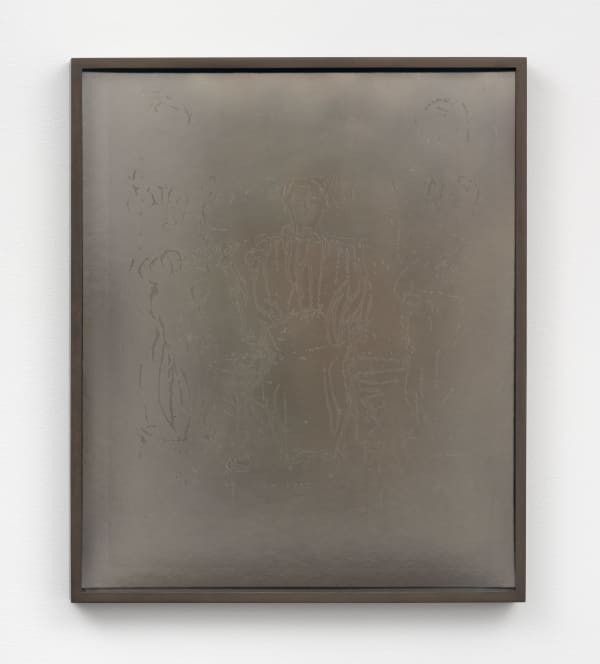-
Lisa Oppenheim
At the Lace Shop and Other Light Drawings -
At a time when considerable attention is being given to repatriation and restitution of cultural objects, Oppenheim turns her critical eye to artworks stolen by various arms of the Nazi regime from Jewish collections. Specifically, she looks at artworks and objects whose whereabouts remain unknown or are known to have been destroyed. These absences allow her to think through particular histories and materials to produce artworks that are constitutive of both. For this exhibition, Oppenheim presents a new series of Jacquard woven textiles that expand upon her previous investigations of the relationship between lace and textile production with the advent of photographic technologies.
-
-
Beim Spitzenhändler 1943/2024 refers to the title of a photograph of a piece of lace looted by the Einsatzstab Reichsleiter Rosenberg (ERR), a special task force created by the Nazis to loot cultural objects from occupied countries during the Second World War. It is not known where or from whom this lacework was looted, only that it was somewhere in France, Belgium, or the Netherlands. The ERR records indicate that it was stolen during the so-called Möbel-Aktion – a systematized campaign in which the entire contents of homes of Jews who had fled or had been deported were confiscated, taking everything from the least to the most valuable objects. The record shows this particular piece of lace was transferred first to the Jeu de Paume in Paris, where it was photographed and catalogued, and then sent to Nikolsburg, a castle in what is now the Czech Republic. Transfer dates and a detailed written description are noted, in addition to a clear documentation photograph. A glaring omission is any information pertaining to whom it was taken from, as if its owners never existed.
-
-
This fine lacework was probably destroyed in its last reported transfer place -- the castle where it was being stored was reduced to ashes in the final days of WWII. Using the Jacquard Loom, Oppenheim evokes the tactility of Beim Spitzenhändler while still referring to the single photographic referent. She utilizes the loom to create a gradient, replacing a single yarn on the loom with each consecutive textile she produces, slowly shifting the image of the lace from light to dark, blurring legibility and monochrome. A single silver thread weaves through each of the individual textiles, referencing the silver gelatin photograph, the only visual record of this object that remains.
-
Other Light Drawings refers to a different mode of image translation. The etymology of the word photograph is a combination of the Greek roots photos (light) and graphe (drawing). In this series, Oppenheim examines the looted collection of the Lederer family, prominent art collectors in Vienna and patrons of Egon Schiele and Gustav Klimt, in particular. More than 300 drawings and watercolors by Schiele and more than 300 drawings by Klimt were stolen by the Gestapo from the home of Serena Lederer (neé Pulitzer) and her family in May 1938 and are still unaccounted for. Some of the looted objects that the heirs were able to retrieve were subsequently sold or donated to important museum collections, including the Metropolitan Museum of Art and J. Paul Getty Museum. Were some of these drawings destroyed in a fire at the Immendorf Castlealong with the Lederers’ collection of Klimt masterpieces, such as Goldener Apfelbaum? Are some of these drawings still with the descendants of Nazi officials to whom they were given by the Gestapo? It is unknown. Using documentation photos from the Lederers’ own inventory, Oppenheim reworks these images in her darkroom, conjuring the lost works, utilizing documents of their presumed loss as the source of new artworks.
-

-
-
-

-
-
-
-
The huge collection of art collector Fritz Mannheimer (1890-1939) ended up in German hands during the Second World War. Much was recovered, but objects are still missing. For the work presented here, Oppenheim used documentation of a textile recorded by the ERR, of which the current whereabouts are unknown. Much of Mannheimer’s textile collection ended up in the collection of the Rijksmuseum, but not this particular piece.
Born in Stuttgart to a Jewish family, the banker and art collector Mannheimer was a very well-known figure in Amsterdam. He moved there in 1918, had an extremely successful career in the international financial world at the Mendelssohn bank and became a naturalized Dutch citizen in 1936. Mannheimer opposed the Nazis from the Netherlands and provided aid to Jews who had fled Germany.
After Mannheimer's death in 1939. Mendelssohn’s debts proved to be huge: over 42 million guilders. Mannheimer’s estate was declared insolvent. Once the occupation had become a fact, Göring and Hitler showed eagerness to get their hands on the Mannheimer Collection. In the end, the administrator had to consent to an involuntary sale to the Mühlmann Agency looting organization and the collection was taken to Germany. The fate of much of his collection, such as the textile recorded by the Nazis -the photograph of which Oppenheim uses as the source material for these two works- remains unknown.
By translating the photograph of the textile through the logic of the Jacquard Loom, Oppenheim does not attempt to recreate what was lost, but rather produce new work out of what little information remains. In this case, all that remains is one image, in positive and in negative. A single silver thread is woven through both textiles, referencing the silver gelatin of the source material.
-

-
Oppenheim was born in 1975 in New York City, where she currently lives and works. She received her BA from Brown University in 1998, and later an MFA from the Milton Avery Graduate School for the Arts at Bard College in 2001. She also attended the Whitney Independent Study Program and the Rijksakademie van beeldende kunsten in Amsterdam.
Oppenheim has been the subject of solo exhibitions at Huis Marseille, Amsterdam (2024); MOCA Cleveland (2017), the FRAC Champagne-Ardenne (2015), Kunstverein in Hamburg (2014), Grazer Kunstverein (2014) and notable group exhibitions including Woven Histories: Textiles and Modern Abstraction, National Gallery of Art, Washington, D.C. (traveled to Los Angeles County Museum of Art; will travel to National Gallery of Canada, Ottawa and The Museum of Modern Art, New York); Afterlives, The Jewish Museum, New York (2021); Off the Record, Guggenheim Museum, New York (2021); Light, Paper, Process: Reinventing Photography, The Getty Center, Los Angeles (2015); Photo-Poetics, Deutsche Bank Kunsthalle, Berlin and Guggenheim Museum, New York (2015); and New Photography at The Museum of Modern Art, New York (2013). She will have a solo exhibition at MUDAM The Contemporary Art Museum of Luxembourg in 2025.
Her work is held in the permanent collections of the Museum of Modern Art, New York; Solomon R. Guggenheim Museum, New York; The J. Paul Getty Museum, Los Angeles; Israel Museum, Jerusalem; Stedelijk Museum Amsterdam; The Centre Pompidou, Paris; Victoria & Albert Museum, London; MIT List Visual Arts Center, Cambridge; and Milwaukee Art Museum, among others.


























